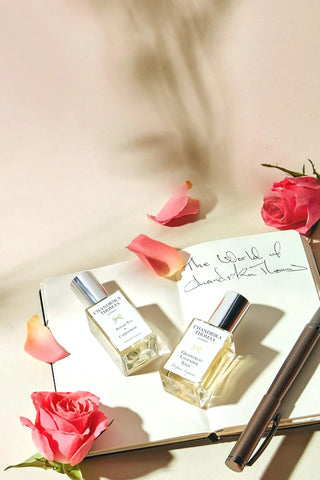It’s not the loudest note in the room, but neroli has a way of staying with you. There’s a certain ease to it, a kind of understated elegance that feels familiar yet hard to pin down. Bright like citrus, soft like petals, with a hint of green that keeps it grounded.
It’s the scent of quiet confidence. The kind you notice on someone who doesn't need to try too hard. In this note, we’re opening the door to neroli, its roots, its unique scent profile, and why it continues to be a favourite in both timeless and modern blends.

The Origins of Neroli
Neroli is the essential oil that comes from the fragile white blossoms of the bitter orange tree (Citrus aurantium). Unlike orange blossom absolute, which is extracted using solvents, neroli is obtained through gentle steam distillation, a method that preserves its bright, green-floral character with remarkable clarity. The result is a scent that feels effortlessly light, yet refined.
Its name dates back to 17th-century Italy, where Anne Marie Orsini, the Duchess of Bracciano and Princess of Nerola, was known for her love of orange flower essence. She would perfume her gloves and bathwater with it, and soon, the aroma became synonymous with her presence. In time, the oil itself took on the name "neroli," a quiet nod to her legacy of understated luxury.
Today, the finest neroli oil is produced in places like Tunisia, Egypt, and Morocco, where the blossoms are harvested by hand during the brief flowering season. It takes thousands of tiny blooms to produce even a small amount of oil, which makes neroli as precious as it is fragrant.


Neroli vs. Orange Blossom – What’s the Difference?
Both neroli and orange blossom come from the same flower of the bitter orange tree, yet they offer distinct olfactory experiences due to differences in extraction methods.
-
Neroli: Obtained through steam distillation, neroli has a fresher, greener profile with light citrus facets and a slightly bitter edge. It carries an airy elegance, often described as crisp, ethereal, and slightly spicy.
-
Orange Blossom Absolute: Extracted through solvent extraction, orange blossom absolute is deeper, richer, and more indolic, with a honeyed sweetness. It leans toward a warm, intoxicating floral aroma, making it more opulent and heady than neroli.
Neroli is favoured for its freshness and versatility, while orange blossom is often used for its lush, sensual depth.

What Does Neroli Smell Like?
The neroli scent is soft, radiant, and effortlessly elegant, a floral with citrus brightness and a touch of green that sets it apart.
At first impression, it feels light and luminous. But unlike sweet florals or juicy citrus notes, neroli is drier, more refined, and quietly complex.
Here’s what defines the neroli scent:
-
Citrus-Fresh and Sparkling – It opens with a delicate citrus glow, like orange zest softened by air and light.
-
Floral and Powdery – Neroli carries a clean white blossom tone, with a soft petal-like quality that’s never too sweet.
-
Green and Slightly Bitter – A subtle leafy edge keeps it grounded, adding a refined sharpness that gives it clarity.
-
Airy and Serene – It has an almost translucent quality, creating a sense of calm and space around it.

Neroli in Assam Tea & Cardamom
Neroli has a remarkable ability to bring balance and brightness to a fragrance. It works beautifully alongside citrus notes like lemon and bergamot, softens white florals such as jasmine and tuberose, and gracefully lifts deeper ingredients like musk, amber, and sandalwood. Its fresh yet sensual personality makes it a beloved note across many perfume families, from sparkling colognes to romantic florals and more opulent blends.
You’ll find neroli at the heart of our Assam Tea & Cardamom perfume, where its luminous quality meets the depth of fine black tea and the soft spice of cardamom. Zesty top notes of mandarin, grapefruit, lemon, and bergamot create a lively opening. As the fragrance unfolds, neroli mingles with rose, jasmine, and a whisper of lavender, forming a tender floral heart. The dry down is smooth and indulgent, with notes of orris, soft musk, and cashmere, leaving a gentle trail that’s both comforting and quietly sophisticated.
The Benefits of Neroli Beyond Fragrance
Neroli isn’t just admired for its delicate scent; it also holds a special place in wellbeing and skincare rituals. In the world of aromatherapy, its gentle, floral aroma is often used to ease emotional tension, offering a sense of calm that feels both soothing and uplifting. It’s the kind of scent people turn to when they need to slow down, breathe deeply, and reconnect with a sense of peace.
In skincare, neroli oil is just as treasured. Known for its calming and balancing properties, it’s often found in natural formulations that aim to soothe sensitivity and support healthier-looking skin. Thanks to its natural antibacterial and anti-inflammatory qualities, it’s a go-to for comforting irritation and helping the skin feel refreshed and cared for, naturally.

Neroli is one of those rare ingredients that feels honest. There’s the sparkle of citrus at first, but then comes something gentler, more comforting, like white petals warmed by the sun. It’s refreshing, yes, but also quietly soothing, as though nature itself is asking you to pause for a moment.
It’s easy to see why neroli finds its place in both fine fragrance and wellbeing. It brings balance. A scent that lifts the mood without overwhelming it, that lingers softly on the skin and in the memory. For those seeking beauty in simplicity, neroli is a gentle reminder that elegance doesn’t need to be loud.
Discover how neroli shines in our Assam Tea & Cardamom perfume, where floral clarity meets warm spice, wrapped in citrus and calm. It’s a scent crafted for presence, comfort, and quiet confidence.




